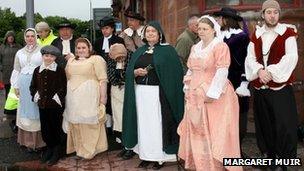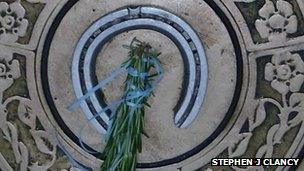The 'powerful myth' of the Paisley curse
- Published

Local people dressed in period costume to see the monument restored
It is a story of witchcraft, a dying woman's curse, industrial espionage, and the rise and fall of Paisley's fortunes.
This potent combination attracted about 20 local people, many dressed in period costume, to hang around on a street corner at six in the morning.
At the centre of it all, the Royal Sculptor Alexander Stoddart's memorial to seven people who were found guilty of witchcraft at the end of the 17th Century.
"In 1696", local historian Stephen Clancy told me, "an 11-year-old girl, the daughter of the Laird of Bargarran, accused seven or eight people of tormenting her.
"As the months went on, she developed all sorts of symptoms. Flying in the air. Coughing up bits of hair, coal, and all sorts of different things.
"Eventually, they decided there was witchcraft involved. And they went to a trial."
As many as 30 people were named, in a series of events which were eerily reminiscent of what had happened in Salem in Massachusetts just a few years earlier.
In fact, historians now think the Paisley witch hunt might well have been influenced - even modelled on - the American experience.
Bodies burned
In the end, four women and three men were sentenced to death - although one man was reported to have committed suicide in his cell before the law could take its course.
The rest were garrotted on Gallows Green in Paisley, their bodies burned, and their ashes interred at Maxwellton Cross south west of the town centre.
As one of the women - Agnes Naismith - died, she screamed out a curse on all the townspeople present, and their descendants.

The horseshoe has been restored to the monument
The witches' mass grave was sealed with a horseshoe. And the legend grew up that Paisley would suffer, if it was ever disturbed.
"Of course in the 1960s, during road works, the horseshoe was lifted," explained Liz Gardiner from Renfrewshire Witch Hunt 1697.
"Now, we know it was coincidence, but from that point on Paisley's fortunes did decline. Last month it was declared the town with the highest number of empty shops of any high street of any town in the UK.
"We know it's a myth. But it's a powerful myth."
That's why Alexander Stoddart's monument was put in place, four years ago - to re-seal the grave and stop the witches' spirits returning to trouble the living.
But over time the replacement horseshoe has worked loose, disturbed by the volume of traffic on the road.
Now it has been reinstated, and Liz Gardiner has high hopes.
"A new Paisley is going to emerge," she said.
"A Paisley of entrepreneurial spirit and vibrancy.
"A Paisley that's using the powerful stories and heritage of its past to build for a new future."
And, she points out, it has worked before.
The 11-year-old girl who had been responsible for making the first witchcraft accusations was Christian Shaw. She went on to make a European tour with her mother.
"They found fine thread being spun in Holland", Liz Gardiner explained.
"They smuggled pieces of a Spinning Jenny back to Paisley under their skirts. And they set up Bargarran Threads, which became Bargarran Mills, which was then bought out by the Coats family.
"So the whole of Paisley's industrial heritage was founded by those two women."
- Published30 May 2012